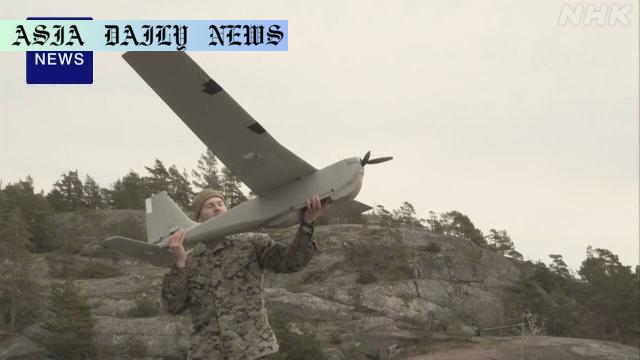Drones are enhancing NATO’s Baltic Sea monitoring after undersea cable disruptions.
NATO employs aerial drones for monitoring the Baltic Sea.
Drones provide enhanced flexibility and real-time data.
Increased surveillance is in response to undersea cable damage.

Drones Revolutionizing Baltic Sea Security
NATO’s latest adoption of unmanned aerial vehicles, commonly known as drones, marks a groundbreaking development in securing the Baltic Sea region. Prompted by recent incidents of undersea cable damage, speculated to involve foreign interference, this initiative seeks to thwart future disruptions. These drones, deployed by NATO countries including Finland and the United States, bring unparalleled flexibility and cutting-edge technology to maritime security efforts. They are equipped with sophisticated camera systems capable of transmitting live visuals, empowering naval forces with heightened situational awareness. In a world grappling with increasingly complex threats, such advancements signify the dawn of a new era in defense strategy.
Technological Advantages of Drone Surveillance
The adoption of drones marks an era where flexibility meets efficiency in surveillance. The unmanned vehicles are designed for rapid deployment following radar alerts. Each unit’s streamlined design, boasting a wingspan of 2.8 meters and a compact body at 1.4 meters long, ensures that they are both responsive and inconspicuous. With faster deployment than traditional naval ships and enhanced capabilities for real-time data capture, drones mitigate risks while offering cost-effective monitoring solutions. According to Finnish Navy Captain Marko Laaksonen, drone technology represents the future of naval operations. High-definition cameras mounted beneath the device provide uninterrupted streaming, enabling swift analysis of potential threats. Further expansions in drone capacity could mark a milestone in European maritime surveillance strategy.
Why Increased Surveillance is Necessary
The Baltic Sea has emerged as a critical site where geopolitical tensions are palpable. The unexplained severing of undersea power lines and communication cables has raised alarm bells across nations dependent on secure connectivity. Although no conclusive evidence identifies the perpetrators, speculation points to Russia, necessitating heightened vigilance. NATO’s decision to expand its monitoring operations reflects an alignment with modern security imperatives where technology plays a pivotal role. This strategic uptick assures not only a deterrence against malicious acts but also demonstrates NATO’s commitment to regional stability. Ships and aircraft have long been involved in patrolling the Baltic but integrating drones ensures a far-reaching and efficient approach to modern maritime challenges.
The Future of Drone Integration in NATO Strategies
This deployment marks only the beginning of what could be a vast integration of unmanned vehicles within NATO’s defense framework. Drones bring immediate benefits, but their full potential extends beyond surveillance. They can be optimized for reconnaissance missions, disaster monitoring, or even threat neutralization in the future. As NATO begins to reap the rewards of this initiative, other regions beyond Europe might similarly benefit from the strategic application of drones. Their rapid deployment, intelligence-gathering capabilities, and adaptability to tough conditions form a strong foundation for future expansions. Marking a strategic shift, this initiative will likely spark bilateral and international cooperation in developing enhanced drone technology suited for military and humanitarian missions alike.
Conclusion
The use of drones in the Baltic Sea is not just a technical upgrade, but a reflection of NATO’s proactive approach to modern challenges. Their integration serves as a testament to the alliance’s ability to adapt and innovate amidst rising uncertainties. Looking ahead, drones are not merely tools but assets that open gateways to other technological possibilities in combatting adverse geopolitical developments and ensuring peace in volatile regions. Balancing technological capacity and diplomatic engagement will remain essential components in leveraging such advancements for global security.



Commentary
The Game-Changing Role of Drones
As technology evolves, so do its applications in fields like defense, security, and humanitarian efforts. NATO’s proactive adoption of drones signals a forward-thinking embrace of unmanned aerial vehicles. This step can influence global opinion on how these tools seamlessly enhance real-time surveillance. Beyond maritime boundaries, these drones represent intelligence, responsiveness, and adaptability, making them indispensable.
Addressing Both Challenges and Opportunities
While the prospects of drone-based monitoring are exciting, it is essential to consider the challenges, including ethical and accessibility issues. Technological misuse and potential over-reliance call for balanced regulation. Yet, the opportunities they provide far outweigh the hurdles when governed with integrity. Their use represents a shift from manual to technologically savvy operations in securing vital resources and territories.
Global Implications
NATO’s initiative will likely have ripple effects worldwide, pushing other alliances and countries towards embracing similar advancements. The impact of such technology can unlock benefits not limited to security but also disaster management and environmental monitoring. It is evident that drones are here to stay, and their integration into essential operations marks a pivotal moment in modern security and defense.